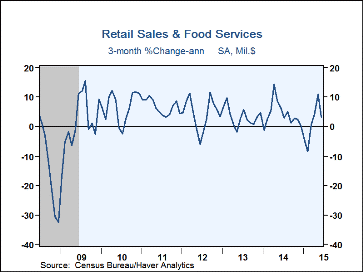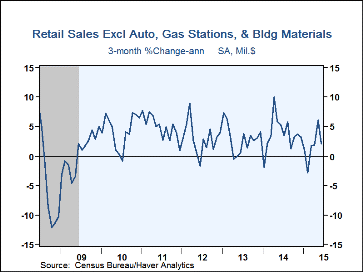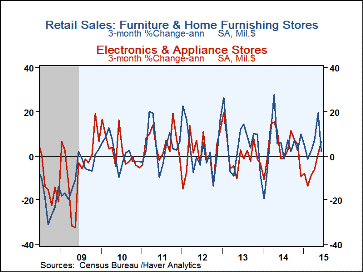 Global| Jul 14 2015
Global| Jul 14 2015U.S. Retail Sales Disappoint With Broad-Based Decline
by:Tom Moeller
|in:Economy in Brief
Summary
Overall retail sales including food services & drinking places during June declined 0.3% (2.9% y/y) following downwardly revised readings of 1.0% and no change during May and April, earlier reported as 1.2% and 0.2%. The June decline [...]
Overall retail sales including food services & drinking places during June declined 0.3% (2.9% y/y) following downwardly revised readings of 1.0% and no change during May and April, earlier reported as 1.2% and 0.2%. The June decline disappointed expectations for a 0.3% rise in the Action Economics Forecast Survey. Sales excluding autos eased 0.1% (+1.1% y/y) following a 0.8% May increase, revised from 1.0%. The gain missed expectations for a 0.6% rise. During the last ten years, there has been a 92% correlation between the y/y change in retail sales and the change in real GDP.
Sales in the retail control group exclude autos, gasoline, building materials & food services. They align with the consumer spending estimates in the GDP accounts. Sales in this grouping were off 0.1% (+3.3% y/y) after an unrevised 0.7% May rise.
Building materials & garden equipment led total sales lower with a 1.3% decline (+1.7% y/y), the third consecutive monthly shortfall. Fewer sales of light motor vehicles followed with a 1.1% decline (+9.9% y/y) after a 1.8% May rise. The decline compared to a 3.5% drop in unit sales of cars and light trucks.
In other discretionary spending categories, sales of furniture & home furnishings fell 1.6% (+6.5% y/y) after a 1.4% gain. Apparel store sales declined 1.5% (+2.5% y/y), reversing a 1.4% increase. Restaurant sales eased 0.2% (+7.8% y/y) and have been flat for two months. To the upside, electronics & appliance store sales jumped 1.0% (0.8% y/y) after two months of negligible improvement. Gasoline service station sales rose 0.8% with higher fuel prices (-16.2% y/y) after 3.7% increase. General merchandise sales gained 0.7% (0.9% y/y) and added to a 1.4% jump. Finally, sporting goods sales improved 0.1% (8.9% y/y) after a 0.6% rise.
In the nondiscretionary categories, health & personal care store sales rose 0.2% (3.0% y/y) following a 0.4% decrease. Food & beverage store sales remained roughly unchanged (2.7% y/y) after a 0.5% rise.
The retail sales figures are available in Haver's USECON database. The Action Economics figures are in the AS1REPNA database.
| Retail Spending (%) | Jun | May | Apr | Jun Y/Y | 2014 | 2013 | 2012 |
|---|---|---|---|---|---|---|---|
| Total Retail Sales & Food Services | -0.3 | 1.0 | 0.0 | 2.9 | 3.9 | 3.7 | 5.0 |
| Excluding Autos | -0.1 | 0.8 | -0.1 | 1.1 | 3.1 | 2.7 | 4.1 |
| Non-Auto Less Gasoline, Building Supplies & Food Services | -0.1 | 0.7 | -0.1 | 3.3 | 3.3 | 2.7 | 3.6 |
| Retail Sales | -0.3 | 1.1 | -0.1 | 2.3 | 3.7 | 3.8 | 4.9 |
| Motor Vehicle & Parts | -1.1 | 1.8 | 0.6 | 9.9 | 7.5 | 8.3 | 9.0 |
| Retail Less Autos | -0.0 | 0.9 | -0.3 | -0.0 | 2.6 | 2.6 | 3.9 |
| Gasoline Stations | 0.8 | 3.7 | -0.9 | -16.2 | -2.7 | -0.7 | 4.3 |
| Food Service & Drinking Places Sales | -0.2 | 0.2 | 1.1 | 7.8 | 6.2 | 3.4 | 5.9 |
Tom Moeller
AuthorMore in Author Profile »Prior to joining Haver Analytics in 2000, Mr. Moeller worked as the Economist at Chancellor Capital Management from 1985 to 1999. There, he developed comprehensive economic forecasts and interpreted economic data for equity and fixed income portfolio managers. Also at Chancellor, Mr. Moeller worked as an equity analyst and was responsible for researching and rating companies in the economically sensitive automobile and housing industries for investment in Chancellor’s equity portfolio. Prior to joining Chancellor, Mr. Moeller was an Economist at Citibank from 1979 to 1984. He also analyzed pricing behavior in the metals industry for the Council on Wage and Price Stability in Washington, D.C. In 1999, Mr. Moeller received the award for most accurate forecast from the Forecasters' Club of New York. From 1990 to 1992 he was President of the New York Association for Business Economists. Mr. Moeller earned an M.B.A. in Finance from Fordham University, where he graduated in 1987. He holds a Bachelor of Arts in Economics from George Washington University.










